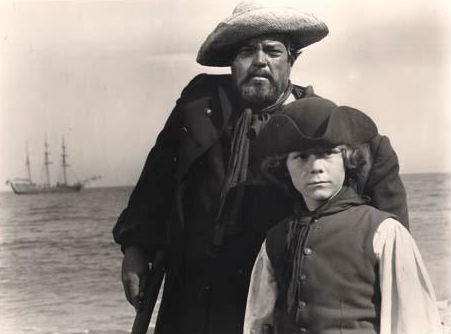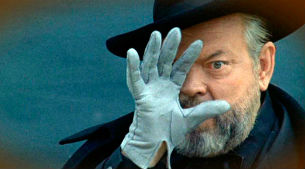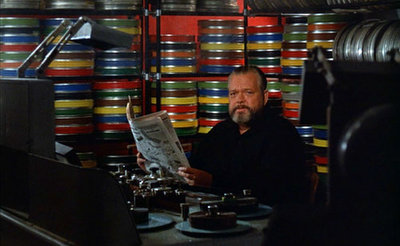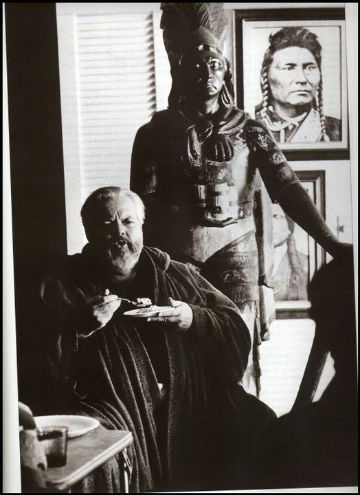
("Treasure Island").
This film, financed with money from
five or six different sources, marked the beginning of my
friendship with Orson Welles. From the very first moment, a mutual
feeling of friendship and interest between us was established and
would continue almost until his death a few years later. The first
time I met Orson was in Paris at the restaurant "Maxim´s", where
Harry, he and I had arranged to meet to see what he thought of the
script we'd given to him seven days earlier. After an exquisite
lunch with excellent dry, white French wine, Welles handed us an
envelope with a script of "Treasure Island" - a version written by
him, under a pseudonym. He told us he wanted the film to be made
based on that script. Harry, who always avoided direct
confrontations, accepted Orson's condition and we shot the scenes
in which Long John Silver appeared using his script, though using
Harry's screenplay for the remaining scenes. I recall that several
weeks later, at the Hôtel du Cap d´Antibes, I was in a meeting with
the chairman of American International, Sam Arkoff, and I asked him
what he thought about the script. He replied: "Listen boy, Harry
has written many scripts for us before, most of them on flights
between Singapore and London, but this one seems to have been
written on a London-Dublin flight." And it was true; in those days
Harry always carried an Olivetti portable typewriter and tortured
his flight companions with his incessant typing, though usually
producing a script by the end of the flight.
That was how in Paris we specified
with Orson the terms of his contract. He demanded to be in charge
of the wardrobe design too and provided the parrot that was to
accompany the character, whose role he played in the movie.
We shot "Treasure Island" almost
entirely in Mojacar and Garrucha (Almeria). Orson and I rented two
houses adjacent to each other in the residential area of Puerto Rey
and there we spent six or seven weeks speaking as little as
possible about the film and much about politics, about Buster
Keaton (whom he adored), about Chaplin (whom he loathed) and, above
all, about many projects which Orson had in mind and which we
decided to implement together.
During our stay in Almeria,
Clifford Irving, a North American who resided in Ibiza, was
arrested for counterfeiting an autobiography of Howard Hughes.
Welles knew that Irving and François Reichenbach had filmed a sort
of documentary in Ibiza about the famous forgery of Elmyr D´Hory
paintings. Fascinated by the idea of forgery and imposture, Welles
managed to convince Reichenbach to let him borrow the filmed
material and thereby complete a film about three "masters of
forgery": Elmyr, Irving and himself. That is how the film "Fake",
coproduced by Reichenbach and Welles, with my participation, came
into being. We shot many scenes in Almería, at night, "borrowing"
the equipment from the "Treasure Island" set. I acted in my first
and last film as a TV presenter. We very quickly finished the film,
which was to end with a final shoot in Chartres. To complete it,
however, I had to pay part of the bail money to get Clifford Irving
out of jail in New York. My encounter with him at the Hotel
Algounquin was really exciting because I have always liked
adventurers and "outsiders."

"Treasure Island" and "Fake"
consolidated my relationship with Welles and we signed a three-year
agreement of mutual exclusivity through which we expressed our
intention to complete all of Orson's unfinished projects. We worked
together in 1972 and 1973. Amongst my many memories, I recall the
morning we found out that ETA had killed Spanish Prime Minister
Carrero Blanco and the long trial sessions against Nixon. Such hot
current news delighted Welles. His most pleasurable activity was
having lunch at Casa Valentín, opposite the Santiago Bernabeu
soccer stadium and having a siesta in the afternoon while watching
the clowns Gaby, Fofó, Miliki and Fofito, whom he adored, on
TV.
We shot scenes for "The Making of
Othello" with Michéal McLiammoir; we had a meeting with Henri
Langlois - the mythical director of the French Cinematheque (Film
Library) - to retrieve part of the negative of "Don Quijote" and,
above all, we restarted and almost finished shooting "The Other
Side of the Wind."
The long task of finishing this
film, on which Welles had worked for years, was probably one of the
most difficult and complex jobs in my career as a producer. At any
rate, it was a most valuable experience, which started in Madrid.
It was there that we devised the strategies to be followed. We did
it at the Hotel Eurobuilding, where Welles stayed for five months,
and continued working in Paris. There, we stayed for the whole
summer at the Plaza Athenée trying to obtain the necessary
finance.
Two people played a decisive role
in ensuring that our project took off. One of them was Dr.
Boucheri, director of "La Casa de Irán" (The House of Iran), a
luxury store located in Champs Elisée, where Persian handicrafts
and Iranian caviar were sold. Boucheri was married to one of the
Shah's sisters and with the promise that we would film in Iran, we
got about one million dollars. However, we had to do so much
"juggling" that I even felt compelled to send a Spanish set
designer, José María Alarcón, over to Iran to convince the Shah's
government that we really intended to film there and promise that
Welles would show up a few months later.
The other person who played a
decisive role at the time of our stay in Paris to complete our
financial requirements was, as it turned out, Klaus Hellwing, an
excellent producer, a financier and a German distributor of
intellectual art house films.

Proximity to Welles was for Klaus a
good enough reason to move heaven and earth to help us. We had to
convince some of Hellwing's TV clients but eventually, with the
help of a lot of good food and French wine, we gradually had it our
way. That same summer we were able to go to the USA with thirty
boxes of Churchill cigars hidden inside A-Z filing cabinets and
almost a million dollars in cash.
We settled in the middle of the
desert, in the house where Antonioni had filmed "Zabriskie Point",
with a technical crew of ten people that included Rich Little, John
Huston, Mercedes McCambridge, Gary Graver and Norman Foster amongst
others. For six months, we tried to complete a film which could
never be finished, undergoing all sorts of experiences and
adventures, some of them comical and others less than comical.
However, finally we had to give up: there was no way to finish that
film. I know that attempts have been made to compile and edit the
material that was shot, but most of it is in Paris, in the hands of
the Iranians who contributed to the financing of the film and who,
in the end, claimed their share of it.
Regarding the end of my
relationship with Orson Welles some lies were told, although he
assured me they did not come from him. Accordingly, I don't want to
go into that matter. I don't deem it relevant to mention the
details of our split considering that our relationship was always
polite and amicable and we had wonderful moments and experiences
together. However, I must make it clear that if I abandoned the
project, I didn't do so for financial reasons. My agreement with
Welles, written and signed by him, envisaged my work as a producer,
not an investor. Welles knew that I didn't have the financial
resources to finance films made in the USA. I did commit myself
though, just as he did, to work on an exclusive basis and try to
finish his uncompleted films. When I became convinced that doing so
would ruin my personal life, jeopardize my relationship with my
family and my children, I decided to go back to Spain. I didn't
make any money or profit, although I don't regret having spent my
time doing what I did. Certain people who were close to Welles and
part of his inner circle - the same ones who are spoiling his works
and making a living from them - tried to justify his difficulties
by linking them to the fact that I pulled out. They have even gone
so far as to say that I had pocketed some of the Iranian money
which in fact never existed, beyond the funds that were spent
appropriately.

During the shooting of "The Other
Side of the Wind" we had many Hollywood personalities, like Dennis
Hopper, Joseph Cotten, Claude Chabrol, Charlton Heston as guest
stars with us. When I said farewell to Welles in Cave Creek, the
small Arizona settlement where we spent over six months, I decided
to pay a visit to Hopper and ask him to play the leading role in a
new project I was preparing. The film was called "The Sky Is
Falling" or "Las flores del vicio" in the Spanish version. The
script was written by Win Wells and Silvio Narizzano was supposed
to be the movie director. Silvio had already attained certain fame
through a film he directed called "Georgy Girl", which launched
Lynn Redgrave's and Charlotte Rampling's acting careers. At the
time, Dennis lived in Taos, New Mexico, an artists' town famous for
its Indian reservation. I flew from Los Angeles to Albuquerque and
from there to Santa Fe, where Hopper was waiting for me with a jeep
loaded with beer that we drank on our way. Now and then we would
stop for a rest and fill the air with the smoke of tobacco that was
fashionable at the time. After spending three days in Taos, where
the Río Grande originates, Hopper promised to come over to Spain a
year later to be in the movie.
After my adventure with Welles, an
office awaited me in Madrid that served the purpose of a
production-distribution company. I started to distribute art house
films, particularly Hungarian and French, apart from rerunning and
sometimes premiering classics by Buster Keaton and Chaplin and
movies like "Johnny Guitar", by Nicholas Ray.
As a producer, albeit with a minority stake in the project, I
participated in the French initiative "Le Complot", which involved
shooting for two weeks in Madrid. For me it was a wonderful
experience to work with great actors like Michel Bouquet, Michel
Duchaussoy, Jean Rochefort and Marina Vlady. I remember that during
the filming, the actors requested to have a word with me one day.
They wanted to talk about Fernando Florido, the makeup artist, who
would approach them to retouch their makeup with a cigar butt in
his mouth just before the director called "action". I recall
Bouquet saying to me: "Andrés, all of us are very good
professionals, but the difference between a good and an excellent
performance might lie in just a simple detail, like the makeup
artist's cigar that is distracting us and making us lose our
concentration." Except for that, the relationship of the actors
with Fernando Florido was great although they wanted me to keep
Fernando from approaching them with the cigar in his mouth.
Sometimes a producer must do little jobs like that.